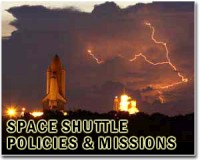 |
Washington (AFP) April 12, 2011 Thirty years after the first space flight of the US shuttle program, NASA announced Tuesday the three retiring orbiters will take up residence as museum pieces in Florida, Virginia and California. NASA's declaration sparked anger in Texas, the home of mission control in Houston, and one senator from the state of Ohio, the birthplace of American airplane flight, demanded a federal probe into the selection process. Discovery, the oldest space shuttle of the fleet, will land at the Steven F. Udvar Hazy Center, a branch of the Smithsonian Institution's National Air and Space museum in Virginia, NASA administrator Charles Bolden said. Atlantis, set to be the final shuttle to fly in June before the US space shuttle program closes, will make its permanent home at Florida's Kennedy Space Center, host of repeated shuttle launches in the past three decades. Endeavour will roost at the California Science Center in Los Angeles, NASA said at a ceremony to honor the first shuttle flight by Columbia in 1981, which also coincided with the 50th anniversary of human spaceflight first achieved by Russia's Yuri Gagarin. And the prototype Enterprise, which never actually flew in space, will be sent to New York for display on a US aircraft carrier docked off Manhattan, the USS Intrepid Sea, Air & Space Museum. The US shuttle program is set to close for good after the final missions by Endeavour in April and Atlantis in June. Discovery ended its last journey to the International Space Station in March. After that, astronauts will rely on Russia's space capsules for transit to the International Space Station. "Each shuttle has stories to be told, history to be shared," said Bolden. "They won't stop inspiring and they won't stop being a part of the fabric of America." The question of where the shuttles would be displayed prompted a flurry of speculation, as curators and lawmakers lobbied for the surge in tourists eager for an up-close look at the journeyed spacecraft. NASA's hefty $28 million price tag did little to dampen excitement and competition among nearly two dozen potential tourist spots and museums clamoring to house a piece of space history. Those who missed out, including Texas, the home of NASA's Johnson Space Center, were vocal in their disappointment. "Houston has played a critical role throughout the life of the space shuttle, but it is clear political favors trumped common sense and fairness in the selection of the final locations for the orbiter fleet," said Senator John Cornyn of Texas. Texas Senator Kay Bailey Hutchison called the news "deeply disheartening," and said it was "unthinkable that the home of human space flight would not represent the ideal home for a retired orbiter. "I specifically asked NASA Administrator Bolden to follow the law, which stipulates priority should be given to communities with strong historical ties to NASA, and in particular the shuttle program." NASA said a series of shuttle artifacts that would be spread nationwide, including shuttle simulators for the Adler Planetarium in Chicago and Texas A&M's Aerospace Engineering Department. Johnson Space Center in Houston would also get flight deck pilot and commander seats, NASA said. In Ohio, the home of the Wright Brothers who invented the first successful airplane and pioneered the first human flight at the turn of last century, Senator Sherrod Brown demanded an investigation. "The fight is not over, which is why I'm calling for a federal investigation into a flawed selection process," Brown said in a statement. Part of the NASA Authorization Act passed by Congress stipulates the "criteria for site selection, including locations that would provide for the display and maintenance of orbiters with the best potential value to the public," he said. In tandem with the shuttle announcement, NASA also hosted a ceremony to honor Columbia, which became the first shuttle to fly in space on April 12, 1981. The two-day flight was meant to test the shuttle's ability to carry astronauts -- in this case, two Americans -- into orbit and back safely. But the Columbia shuttle disintegrated on its return to Earth during its 28th mission in 2003, killing all seven astronauts on board. The other original member of the five-strong fleet, the shuttle Challenger, exploded 73 seconds after liftoff in 1986. All seven astronauts died, including Christa McAuliffe, who had aimed to be the first teacher in space. "They were all true American heroes who made the ultimate sacrifice for this country," Bolden said.
Share This Article With Planet Earth
Related Links Shuttle at NASA Watch NASA TV via Space.TV Space Shuttle News at Space-Travel.Com
 NASA to decide shuttle display locations
NASA to decide shuttle display locationsWashington (UPI) Apr 9, 2011 NASA officials are gravitating toward a decision on where several retired space shuttles will be displayed for future generations. At least 20 sites across the country are vying for one of the shuttles, including the National Museum of the U.S. Air Force outside of Dayton, Ohio, and the Kennedy Space Center in Mims, Fla. NASA Administrator Charles Bolden is expected to announce ... read more |
|
| The content herein, unless otherwise known to be public domain, are Copyright 1995-2010 - SpaceDaily. AFP and UPI Wire Stories are copyright Agence France-Presse and United Press International. ESA Portal Reports are copyright European Space Agency. All NASA sourced material is public domain. Additional copyrights may apply in whole or part to other bona fide parties. Advertising does not imply endorsement,agreement or approval of any opinions, statements or information provided by SpaceDaily on any Web page published or hosted by SpaceDaily. Privacy Statement |